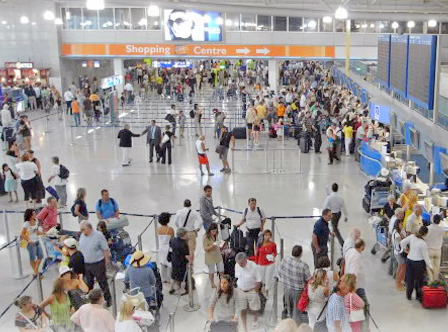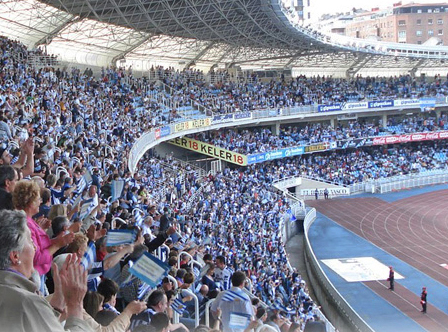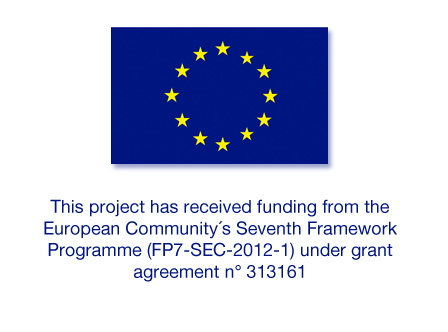PROJECTS



IK4-TEKNIKER is participating in the European eVACUATE project, the results of which will be tested at the Real Sociedad soccer stadium, the Bilbao Metro and Athens Airport. These systems will facilitate and speed up the exit of people and are designed to be adapted to any scenario or situation.
Every other weekend an average of 24,000 people converge on the Anoeta Stadium, which is 74% of its maximum possible capacity. Throughout the season in up to six matches in the BBVA League, the Anoeta Stadium has had more than 28,000 spectators, a figure which rises to over 30,000 when the stadium is full. On the other hand, over 300,000 people use the Bilbao Metro every day. In the event of an emergency situation occurring in either of these infrastructures, the speed of evacuation would be a key variable to minimise the risks and guarantee the safety of the public.
The current safety systems of any infrastructure, like emergency exits, fire suppression systems, evacuation plans, etc. meet all the safety regulations and legislation in force to ensure proper evacuation.
Institutions like Real Sociedad soccer club or Metro Bilbao are a benchmark in safety standards, but they are maintaining a proactive attitude to progressively improve their evacuation systems. The new technologies enable safety systems to take into account crowd dynamics that occur during an evacuation in order to maximise safety for all concerned.
The sensation of being trapped creates a situation of mental confusion in people and some may experience panic attacks and cause the evacuation channels like staircases or doors to exceed capacity, thus preventing or slowing down evacuation.
In order to seek solutions for these phenomena, the European Commission has launched the eVACUATE project, an initiative in which IK4-TEKNIKER is participating, and which is designed to gain a better understanding of how emergency evacuations work and to provide even safer systems for logistics and decision-making in critical situations.
The initiative, which has a total budget in excess of 13 million euros, will be designed so that it can adapt dynamically to any kind of scenario or situation. The aim is for people trapped during a complicated evacuation to constantly receive sufficient information so that they realise what is going on and have knowledge at all times about the best evacuation route even if the situation changes. Through the various intelligent systems, which will combine different communication technologies, analysis of the situation on the ground and dynamic signage of the active evacuation route, it is anticipated that the speed of evacuation will increase by over 20%.
Real Sociedad and Metro Bilbao
The systems designed during the development of the project will be subsequently validated at the facilities of organisations that have large crowds like Real Sociedad, the Bilbao Metro or Athens Airport, organisations that are also collaborating in the project.
Both Real Sociedad and the Bilbao Metro will be testing the technologies developed in the course of the eVACUATE project in two of the four pilot tests in real environments that are scheduled as part of the validation phase.
The new evacuation systems in the project will be obtaining data in real time about the situation in these smart spaces during the evacuations, thanks to the technologies developed, and they will be capable of generating predictions of future evacuation scenarios. The data obtained will be processed by means of artificial intelligence systems, vision systems and other techniques to be able to determine the best evacuation route at each moment; this will then be passed on to the people by means of dynamic signage systems and their own smart phones, thus achieving an evacuation that is as efficient as possible.
One of the key technologies that will be part of the whole system will be three-dimensional vision of the prevailing evacuation situation. This technology, combined with systems to locate and process all the data obtained, will facilitate the detection of the behaviour of the people to be evacuated as a whole, and the exchange of information between the people involved, including the evacuated people themselves.
Important European organisations
The eVACUATE project is very complex and that is why it has the participation of twenty or so organisations, including companies, universities and research centres from eight community countries, including multinational companies like the Spanish company INDRA and Telecom Italia, top universities like the University of Dresden and the Polytechnic of Turin, and R&D centres like IK4-TEKNIKER itself.
This Eibar-based organisation will undertake to create the architecture of the smart spaces. This smart space will identify the sources of the possible problems during the evacuation and will also identify the people involved in a dangerous situation. At the same time, the system created by the R&D centre will place smart signage elements along the evacuation routes and will facilitate the first response to the people involved in the evacuation.
Real Sociedad
Real Sociedad is a soccer club going back a hundred years that has 29,277 members and hopes to go on increasing its social mass. The club is currently remodelling the Anoeta Stadium, where the club plays its home matches. Right now, the club located in the Basque province of Gipuzkoa is continuing to work with the institutions so that the remodelling will be completed as soon as possible and meet quality standards of an international level.
Metro Bilbao
Metro Bilbao was born to become the great backbone of public transport in the Basque province of Vizcaya, to facilitate the mobility of those who have to get from one part of the city to another. The metro is a public means of transport that structures the connection between Bilbao and the rest of Vizcaya and every year transports over 85 million passengers. The suburban network of Bilbao has two lines, 40 stations, 24 of which are underground.



